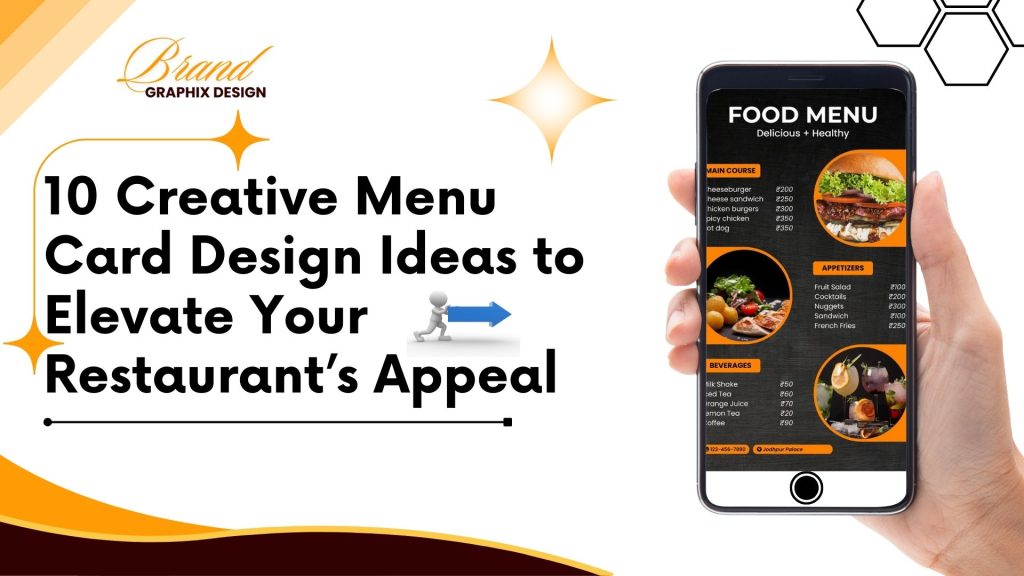Menu cards are more than just a list of dishes; they are an essential part of your restaurant’s branding. A well-designed menu card can communicate your restaurant’s style, set the right mood, and even influence what customers order. In today’s competitive market, creative menu card design is a great way to stand out and leave a lasting impression on your customers. In this blog, we will explore 10 creative menu card design ideas that can help elevate your restaurant’s appeal and attract more customers.
1. Minimalist Menu Design for a Modern Look
Minimalist design is all about simplicity and elegance. It uses clean lines, ample white space, and a limited color palette to create a sleek and modern look. A minimalist menu is easy to read and navigate, making it perfect for upscale or contemporary restaurants. This design style works well when you want to highlight a few signature dishes or special items, allowing the focus to be on the food rather than the design.
- Use a simple, clean layout with plenty of white space.
- Choose a limited color palette for a sophisticated feel.
- Highlight key dishes with elegant fonts and subtle accents.
2. Vintage-Inspired Menu Design for a Nostalgic Touch
Vintage-inspired menu design can add a nostalgic feel to your restaurant, making it warm and inviting. This style uses retro fonts, classic color schemes, and old-fashioned illustrations to evoke a sense of history and tradition. It is ideal for restaurants that serve comfort food, traditional dishes, or have a rustic theme. Vintage menu design can create an emotional connection with customers and make them feel at home.
- Incorporate retro fonts and classic design elements.
- Use muted colors like brown, beige, and soft pastels.
- Include vintage illustrations or patterns to enhance the nostalgic feel.
3. Illustrated Menu Design for a Fun and Playful Vibe
An illustrated menu design can add a fun and playful vibe to your restaurant. Hand-drawn illustrations of food items, ingredients, or themed elements can make your menu more engaging and memorable. This style works well for casual eateries, family restaurants, or places with a unique concept. Illustrated menus are visually appealing and can make customers curious about your dishes.
- Use hand-drawn illustrations to showcase dishes or ingredients.
- Incorporate fun elements like doodles or sketches to add personality.
- Ensure the illustrations align with your restaurant’s theme.
4. Transparent Menu Cards for a Modern Twist
Transparent menu cards use materials like acrylic or clear plastic to create a sleek and contemporary look. This design is eye-catching and unique, giving your restaurant a modern edge. Transparent menus can be combined with minimalist text and simple graphics to keep the focus on the food. They are ideal for trendy cafes, upscale restaurants, and places with a chic, modern vibe.
- Use clear materials like acrylic or transparent plastic.
- Keep the text simple and easy to read.
- Combine with minimalist graphics for a clean and modern look.
5. Eco-Friendly Menu Design for a Sustainable Approach
Eco-friendly menu design reflects your commitment to sustainability and appeals to environmentally conscious customers. Use recycled paper, soy-based inks, or other sustainable materials to create a menu that is both stylish and responsible. This design works well for organic restaurants, farm-to-table eateries, or any place that wants to promote its green values. Highlight sustainable practices or locally sourced ingredients to further emphasize your eco-friendly approach.
- Choose recycled or biodegradable materials for printing.
- Use natural colors like green, brown, and beige.
- Include information about your sustainable practices or sources.
6. Storytelling Menu Design to Create an Emotional Connection
A storytelling menu design tells the story of your restaurant, the inspiration behind your dishes, or the journey of your ingredients. This type of menu uses visuals, text, and design elements to create a narrative that engages customers on a deeper level. Storytelling menus are perfect for restaurants that have a unique concept, a rich history, or a strong brand identity. They make customers feel more connected to your brand and enhance the dining experience.
- Include short stories or descriptions about the dishes or ingredients.
- Use visuals like photos or illustrations to support the narrative.
- Ensure the design reflects your brand’s personality and values.
7. Fold-Out Menu Design for a Unique Experience
Fold-out menu designs offer a unique and interactive experience for customers. These menus can be unfolded in creative ways, revealing different sections or pages as they open. Fold-out menus are ideal for restaurants with an extensive menu, as they allow you to present a lot of information without overwhelming the customer. They can also be used to create a sense of surprise and delight, making the dining experience more memorable.
- Create a fold-out design that is easy to navigate.
- Use different sections or pages to organize menu categories.
- Incorporate creative folds or layouts to add an element of surprise.
8. Digital Menu Design for a High-Tech Experience
Digital menu design uses technology to create an interactive and engaging experience for customers. This could include menus displayed on tablets, digital screens, or even through QR codes that customers scan with their smartphones. Digital menus are ideal for tech-savvy restaurants, cafes, or quick-service eateries that want to streamline their ordering process and reduce paper waste. They can be easily updated with new items, specials, or promotions, making them highly versatile.
- Use digital screens or tablets to display the menu.
- Incorporate QR codes for easy access via smartphones.
- Ensure the digital menu is user-friendly and visually appealing.
9. Themed Menu Design to Match Your Restaurant Concept
Themed menu design aligns with the overall concept or theme of your restaurant, creating a cohesive and immersive experience. Whether it’s a beach-themed seafood restaurant, a vintage diner, or a jungle-themed cafe, the menu design should reflect the same style and mood. Themed menus help strengthen your brand identity and make the dining experience more enjoyable and memorable.
- Use colors, fonts, and graphics that match your restaurant’s theme.
- Incorporate themed elements like illustrations or backgrounds.
- Ensure the design enhances the overall ambiance of the restaurant.
10. Interactive Menu Design for a Fun Dining Experience
Interactive menu design involves elements that customers can touch, feel, or engage with, creating a more dynamic dining experience. This could include scratch-and-sniff menus, pop-up elements, or menus with removable parts. Interactive menus are great for family-friendly restaurants, cafes, or eateries with a unique concept. They encourage customers to explore the menu and add an element of fun to the dining experience.
- Incorporate elements that customers can touch or interact with.
- Use innovative materials or features like pop-ups or textures.
- Make sure the interactive elements align with your brand’s theme.
Transform Your Restaurant with Creative Menu Design
Creative menu design is a powerful tool to enhance your restaurant’s appeal and create a memorable dining experience. Whether you choose a minimalist style, vintage charm, or a digital approach, your menu should reflect your brand’s personality and values. If you need help designing a unique and eye-catching menu card for your restaurant, we’re here to assist. Contact us today at +91 91189 11171 to elevate your restaurant’s appeal with a creative menu design.



